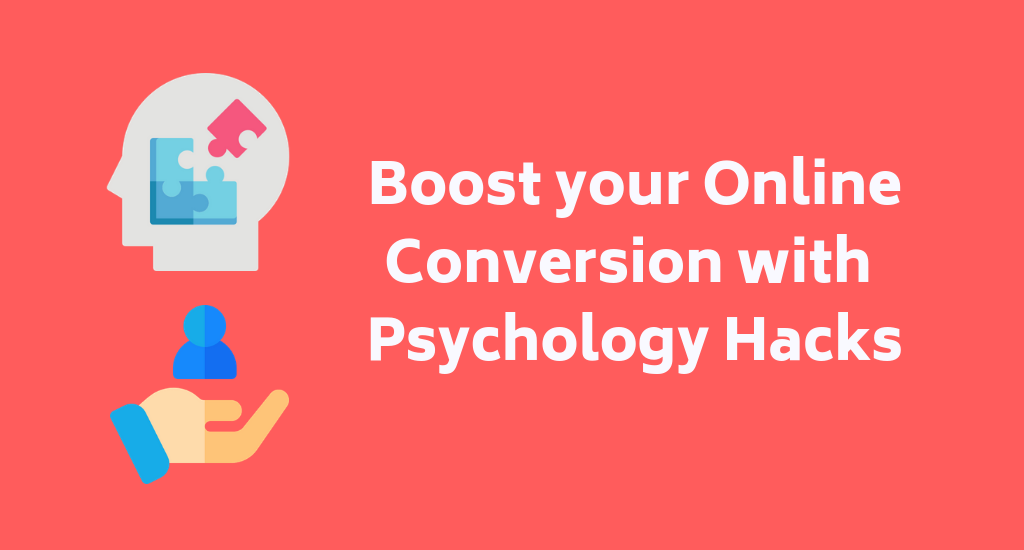These 9 eCommerce hacks are scientifically based. Use them to increase conversion of your online store!
Successful selling is all about behaviour. That’s why it’s vital to understand what makes your customers tick by getting into their minds. Nothing works better than basic rules of psychology, which can help you spark more conversion-oriented behaviour. Leverage these 8 most common psychological principles using our eCommerce tricks to drive up your conversion rates. The practical examples we mentioned will make the task a lot easier.
1. The law of Pragnanz (or the KISS principle)
Pragnanz in German stands for pithiness and means nothing else than keeping things short and simple. Our brains are innately hardwired to prefer simple messages over complex and chaotic ones. The same rule applies to online customer behaviour. Simplicity sells, complexity fails, states the first of our eCommerce hacks!
Go and test it in your store:
- Keep your CTAs short but strong.
- Limit the number of fields in a form, reduce pages in the check-out.
- Give a clean and neat look to all texts on your website: highlight links, apply. bullet points, and make your content searchable.
2. Social proof is one of the top eCommerce hacks
One of Cialdini’s principles of influence refers to the human tendency to follow the behaviour of others, especially if one is unsure of what to do. We are also predisposed to see safety in big numbers. The very same applies to customers visiting your store. For example, if they see scores of positive opinions from other shoppers, they themselves will be more inclined to give your product/service a try. Lots of people use it, so it must be worth the money – that’s the logic. Lots of eCommerce hacks base on such basic principles.
Go and test it in your store:
- Encourage users to sign up for a newsletter by showing numbers: “Join 20.000 buyers to get the biggest discounts straight to your mailbox.”
- Include “People who viewed this product also bought” feature.
- Present reviews, testimonials, and ratings in strategic places on your website.
- Add social sharing buttons under your blog posts.
3. Authority
Another Cialdini principle states that people are easily attracted to brands if they position themselves as leaders or experts in the field. That’s why your business should sound as credible, expert and professional as possible. Today we are bombarded with various marketing messages, mostly biased, so any impartial opinion provided by an expert can influence your customers’ buying behaviour. It doesn’t really matter if the person that supports you is a real authority in their field, only the first impression matters here. Among other eCommerce hacks, this one is pretty shady and often leads to social engineering based scams.
Go and test it in your store:
- Use the power of influencers to endorse products you sell.
- Establish a position of a thought leader in your industry by creating useful content that solves customers’ pain points.
- If possible, add authority badges from sources trusted by consumers, e.g. “award-winning”, “recommended by”.
- Include “as featured in” and “recommended by” to certain products.
4. Scarcity
Products that are promoted as being scarce or of limited availability are usually more appealing and thus more desired. As human beings, customers are driven by the deeply ingrained FOMO, the fear of missing out. This feeling is far stronger than the desire of gaining. By showing that your products are scarce, customers will see their value immediately. Give your customers a limited time to act, a limited choice, and they will be more likely to convert. Scarcity is often described as a very effective social-engineering technique, make sure to use it among other eCommerce hacks.
Go and test it in your store:
- Add “There are six people viewing this product” feature.
- Introduce “Offer ends in…” or “X people are viewing this product”.
- Announce free deliveries like: “Free delivery only this weekend”.
- Consider adding a countdown timer: “This offer ends in X hrs: X mins”.
5. Commitment and consistency
According to Cialdini, we tend to stick with what we have already committed to. Once your customer makes a small commitment for a start, they are more likely to keep to it in the future. Why? People want to appear as consistent and to keep their self-image up-to-date, they are likely to stay and buy with you. Remember that it’s better to start with small, free-of-charge “yeses” like the newsletter signup only to move to bigger ones like purchases later on.
Go and test it in your store:
- Invite customers to sign up for a webinar or newsletter.
- Encourage them to share your content on your social media.
- Apply retargeting to follow your customers.
- Ask for their contact details.
6. Liking
Likeability is a powerful conversion driver. Customers are more likely to shop with a brand or store they feel emotionally connected to. The physical appeal, similarity, positive rapport, and positive associations play a role here. In other words, make your online store visually appealing, show that you are customers’ friend, develop relationships across social media. Last, but not least, keep your image consistent with your values. The emotional push doesn’t come without a compelling story and personality.
Go and test it in your store:
- Create an engaging story in “About us” page.
- Get actively involved in conversations on social media.
- Make your website well-designed and user-friendly.
- Stay away from a strained formal style of writing.
7. Decoy effect
You can apply this psychological rule to your pricing page. Provide your customers with three pricing options, with the middle option being the decoy price, e.g. $59 digital subscription, $125 print subscription, $125 digital and print subscription. The strategically placed decoy price is close to the most expensive option but, when it comes to value, it’s close to the cheapest option. The decoy price is so skewed that it naturally points to the highest-priced plan as the best one. The whole principle is based on the cognitive bias, so your customers get tricked by their own minds. Definitely one of the most useful eCommerce hacks!
Go and test it in your store:
Decoy strategy is perfect for subscription-based, sign-ups, generally – all kinds of pricing plans.
8. Paradox of choice
The paradox of choice, more carefully discussed by Barry Schwartz in his TED lecture, means that more options lead to decision paralysis and thus fewer actions. Fewer options, in turn, lead to more actions. Give your customers a limited choice, and the chances of converting them will increase significantly. To give you an example, Amazon displays only a limited number of categories, each with 7 products at most.
Better be sure not to choose between our eCommerce hacks and just use all of them!
Go and test it in your store:
- Facebook Like button vs. Facebook Share button – if you care about sharing, get rid of the former.
- Cut on the number of social sharing buttons, e.g. from 5 to 2 or 3.
- Create a landing page so that the customer has only 3 options to go: 1) Buy a product, 2) Read about a product to buy it, 3) Reject it and navigate to a different site.
9. Instant gratification
In the era of instant messaging and omnipresent buzz in social media, humans are programmed to want things. Mostly, they want them now. Here’s where the concept of instant gratification comes in. It is all about satisfying demands without delay or deferment. The habit of impatience is especially deeply ingrained in the gamers’ community (sorry, we couldn’t escape this comparison!), let alone millennial gamers. With their one-click mentality, quick arrival and fast shipping make their brains light up. Nothing will outperform digital delivery, however. Either you offer an immediate solution to customer demands, or they will walk away. But is good service one of the eCommerce hacks? Apparently, it is.
Go and test it in your store:
- Offer email delivery in your store e.g. by selling digital games.
- Give information about a product/game via instant messaging.
- Provide 24/7 chat or email support for more complex cases.
- If you can’t deliver instantly, be frank about it – let users know: “sorry, but you’re going to have to wait”.
Conclusion
Psychology can and should affect your conversion. All these psychological principles are so fiendishly difficult to resist because they appeal to the deepest customers’ subconscious. Best of all, they cost nothing – you can improve the conversion rates in your store without straining your budget. Now is the right time to learn how your customers’ minds work and use their natural behaviour to your advantage!
Find more useful brilliant tips on our blog!
About the author

- Berry
- E-commerce owner and blogger. A trained accountant and an avid gamer. Healthy food aficionado.
Latest entries
 Article2018.09.27The Pros and Cons of Order Fulfillment
Article2018.09.27The Pros and Cons of Order Fulfillment Article2018.09.27The Good and the Bad of eCommerce Platforms for Large Enterprises
Article2018.09.27The Good and the Bad of eCommerce Platforms for Large Enterprises Article2018.09.24How Wholesale Directories Like Worldwide Brands Can Empower Your Retail Business
Article2018.09.24How Wholesale Directories Like Worldwide Brands Can Empower Your Retail Business Article2018.09.24eCommerce Software for Large Enterprises: How to Choose It in 8 Steps
Article2018.09.24eCommerce Software for Large Enterprises: How to Choose It in 8 Steps



